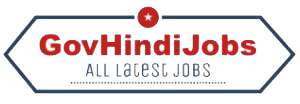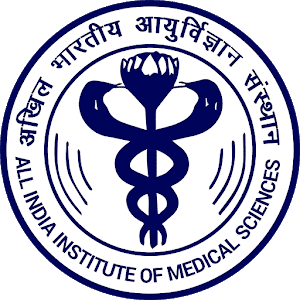Last Updated on अप्रैल 9, 2020 by Gov Hindi Jobs
These guidelines are subject to change in terms of GOI guidelines/ clarifications, if any, from time to time.
Scheme of Examination: The examination will adjoin a Computer Based online mode of exam for the
post of Medical Record Technician (MRT) is as below:
The examination will consist subject mentioned below for the post of Medical Record Technician (MRT):
Time Duration – 2 Hours*
| Part | Subject | Max. Marks/Questions |
| A | General Intelligence & Reasoning | 20 |
| B | Quantitative Aptitude | 10 |
| C | English Language & Comprehension | 20 |
| D | Subject Knowledge | 100 |
Indicative Syllabus for Examination for the post of Medical Record Technician (MRT):
A. General Intelligence & Reasoning:
It would include questions of both verbal and non-verbal type. This component may include questions on analogies, similarities and differences, space visualization, spatial orientation, problem solving, analysis, judgment. Decision making, visual memory, discrimination, observation, relationship concepts, arithmetical reasoning and figural classification, arithmetic number series, non-verbal series, non-verbal series, coding and decoding, statement conclusion, syllogistic reasoning etc. the topics are, Semantic Analogy, Symbolic/Number Analogy, Figural Analogy, Semantic Classification, Symbolic/ Number Classification, Figural Classification, Semantic Series, Number Series, Figural Series, Problem Solving, Word Building coding &
decoding, Numerical Operations symbolic, Operations, Trends, Space Orientation, Space Visualization, Venn Diagrams, Drawing inferences, Punched hole/ pattern-folding & unfolding, Figural Pattern – folding and completion, indexing, Address matching, Date & city matching, Classification of Centre codes/roll numbers, Small & Capital letters/mimbers coding, decoding and classification, Embedded Figures, Critical thing, Emotional Intelligence, Social Intelligence, Other sub-topics, if any.
B. Quantitative Aptitude:
The questions will be designated to test the ability of appropriate use of numbers and number sense of the candidate. The scope of the test will be computation of whole numbers, decimals, fractions and relationships between numbers, Percentage, Ratio & Proportion, Square & Cube roots, Averages, Interest, Profit and Loss, Discount, Partnership Business, Mixture and Allegation, Time and Distance, Time & Work.
For VH candidates of 40% and above visual disability /afflicted by cerebral palsy and locomotor disability candidates and opting for scribe there will be no component of Maps/Graphs/Diagrams/Statistical Data in the General Intelligence & Reasoning I General Awareness Paper.
C. English Language & Comprehension:
In addition to the testing of candidates’understanding of the English Language, its vocabulary, grammar, sentence structure, synonyms, antonyms and its correct usage, etc. his/her writing ability, would also be tested.
D. Subject Knowledge:
• Hospital and Patient-care Appraisal
Objectives of Hospital, Parameters of Good Medical Care/Patterns of Patient Care, Functions of Hospital
• Role of a Hospital in Health is- Delivery Systems (HCDS)
• Classification of Hospitals
• Hospitals Organization and its analysis Chart of Organization, Board and Committees, Duties and responsibilities thereof
• Departmental Administration Delegation, Decentralization
• Patient Care Appraisal (PCA) History of Medical Audit, Tools and Techniques, Various Phases of Medical Audit
• Departments and Service Units
Clinical Departments, Diagnostic and therapeutic Services (including Clinical Laboratories,
Radiology, Physical Medicine and Rehabilitation and Pharmacy Services), Nursing
Department, Dietary Department, Outpatient Department, Accident and Emergency Services
Department, Medical Social Service Department (viii) General and Medical Stores, Blood
Bank, Medical Library Services, Service units in a Hospital Laundry, Housekeeping, CSSD,
Miscellaneous Services : Engineering, Mortuary and Transport Services.
• Basic Anatomy
Definition of Anatomy & Physiology, Types of Anatomy (including systemic), Definition of topographic term/term used to describe the body, Descriptions of various regions of the body.
• Basic Physiology
Introductory Lectures or specialization of tissues, Homeostasis and its importance in mammals, Blood and lymphatic system Cardiovascular system, Excretory system, Skin and temperature regulation, Respiratory System, Digestive system and metabolism Endocrinology, Reproductive System, Digestive System and Metabolism Endocrinology, Reproductive System, Nervous System, Special Senses, Muscles
• Basic Pathology and Microbiology
Definitions and Classification of diseases: Inflammatory diseases- viral and fungal,
Inflammatory diseases- Parasitic, Degenerative diseases, Fatty degeneration, Amyloid etc., Tumors- Definition, etiology & classification, Disturbances in blood flow, Pigment disorders,
Hereditary diseases, C.V.S. Blood vessels, V.S. Heart, Respiratory System, G.I. tract, Liver
Lymphatic System, Genitourinary System, Skeletal System, Blood, Central Nervous System,
Endocrine System
Clinical Pathology: Normal Composition of blood, disease of RBCs, WBCs, Platelets, Coagulation factors and disorders, Blood groups and cross matching, Blood transfusion, Urine Composition: variation in common disease, CSP and body fluids, Gastris and Duodenal contents, Fasces, Parasites, Introduction and historical background, Classification special, Characteristics of organisms bacteria’s, Asepis, Disinfection Antiseptics, Allergy study of
pathologenic organisms, Non-pathology organisms, Virus and fungus, Parasitic diseases- their stance in India with lab Diagnosis.
• Medical Terminology:
(i) Objective
(ii) Basic
(iii) Elements of Medical Terms:
Roots, Prefixes, Suffixes, Colours, Numerals, Symbols, Abbreviation
(iv) Terms pertaining to Body as a whole.
Terms relate to Investigations, and operation, treatment of conditions, disordersSkin and Breast (integumentary system), Musculoskeletal, Neurological and Psychiatric,
Cardio-viscular, Blood and blood forming organs, Respiratory, Digestive, Uro-genital,
Gynaecological, Maternal, Antenatal and Neonatal conditions, Endocrine and Metabolic,
Sense organs of: Vision, Hearing
Systemic: Infectious diseases, Immunological diseases, Diseases of the Connective Tissues,
Diseases of the Connective Tissues
Geriatrics and Psycho geriatrics.
Supplementary terms: Selected terms relatingOncology, Anaesthesiology, Physical Medicine and Rehabilitation, Nuclear Medicine, Plastic
Surgery of Burns and Maxillofacial, Radio-diagnosis, Radiotherapy
• Biostatistics:
(i) Introduction to Statistics
(ii) Methods of collection of data
(iii) Measures of central tendency (simple average, G.M., H.M., Mode and Median)
(iv) Measures of dispersion (Standard deviation, Range, variance, average deviation)
(v) Sampling; Definition, Methods of sampling (randoin systematic, stratified, cluster)
(vi) Correlation and regression: Significance, linear correlation, correlation coefficient, linear regression.
(vii) Time series analysis- concept and its utility, component of time series.
(viii) Test of significance.
(ix) Graphical presentation of data.
(x) Probability- concept and definition.
(xi) Uses of statistics.
1. Sources of hospital statistics (In- Patient census, Out – Patient Deptt, and Special Clinics).
2. Definitions (live, birth, foetal death, immaturity, cause of death, underlying cause of death inpatient bed etc)
3. Analysis of hospital services and discharges.
4. Indices (Bed occupancy, average length of stay, bed turn – over internal, death rate birth rate etc.)
5. Vital statistics.
6. Uses and Limitations of hospital data.
7. Method of compilation of various Health Returns/Statistical Returns.
• Healthcare Organisation:
Introduction to Principles of Management and Administration
Scope and importance of management, Principles of Management, Functions of a Manger (POSDCORB-E). Management Techniques, Material Management, Personal Administration
Financial Administration
Public Health Structure in India:
With relation to public Health & medical Care, Constitutional lists, Various five years plans
and priorities,
Role of Voluntary Health Organisation
Basic facts of Health in India.
Current Objectives and strategies:
Population Dynamics, Community Health Worker schemes.
National Health Programmes of Medicine and Homeopathy.
Other programmes of relevance to Health Sector:
Family Welfare, Medical Termination of Pregnancy, National Population Policy, Maternity
and Child Health.
• Medical Record Science
Introduction to Medical Record Science, Development, Analysis and Uses of Medical Record.
Development Medical Record Forms, basic and special.
Order of Arrangements:
Ward, Medical Record Department, Source Oriented Medical Record, Problem oriented
MedicalRecord, Integrated Medical Record.
Analysis of Medical Record:
Quantitative, Qualitative.
Uses of Medical Records:
As a personal document, As impersonal document.
Values of the Medical Record
• International classification of Diseases
Classification of diseases as per I.C.D
*Compensatory time of 1 hour will be provided to PwD candidates, who are eligible for the same as mentioned in Para- 11 above.
Questions will be Objective Type Multiple Choice, Set in both Hindi and English in respect of Parts A,B, C&D.
There will be negative marking of 0.25 marks for each wrong answer •
Note- I: The Institute reserves the right to conduct the examination through Computer based online mode. The Institute also reserves the right to introduce additional stage of examination which would be notified at suitable time if considered necessary.
Note-IT: Any representation to key of the examination will be scrutinized with the help of experts, wherever necessary, and evaluation in that case will be done with modified answer key. The decision of the AIIMS, Patna in this regard will be fmal and no further representation will be entertained.




